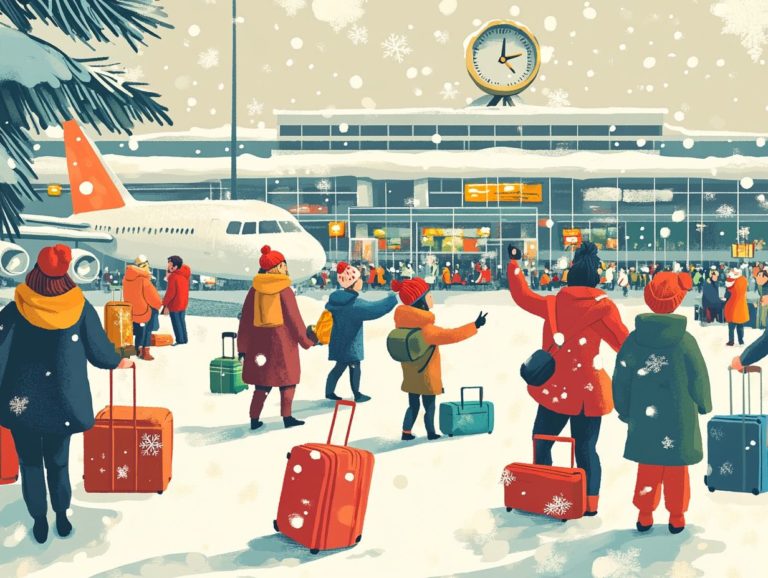Tips for Understanding Different Time Zones
Time zones are pivotal in your daily life. They impact everything from business meetings to travel itineraries.
But what are time zones, and what prompted their creation? This exploration delves into the history of time zones, how they are established, and the challenges they pose in our increasingly interconnected world.
Get ready to uncover exciting strategies for managing time differences! With the right tools, you can easily navigate the complexities of multiple time zones.
You’ll discover strategies for managing time differences, learn about the technology that streamlines tracking, and gain practical tips to effortlessly navigate the complexities of multiple time zones.
Contents
Key Takeaways:
- Understanding the history and purpose of time zones can help you appreciate their significance in daily life.
- Geographical and political factors determine how time zones are established.
- Effective time management strategies and technologies can help you navigate challenges with different time zones.
What are Time Zones and Why Do They Exist?
Time zones are the geographical regions that share the same standard time, a clever concept designed to help coordinate daily activities across various locations. They exist to account for the Earth’s rotation and the sun’s shifting positions, which influence local time and, in turn, affect your circadian rhythm the internal clock that helps regulate your sleep and wake cycles and overall health.
Typically, each time zone differs by one hour, factoring in daylight saving time and standard time adjustments. This allows you to effectively manage your schedules for travel, business meetings, and more.
Understanding time zones is crucial for synchronizing activities and maintaining well-being. When you travel across multiple time zones, those abrupt changes can lead to travel fatigue and the notorious jet lag, disrupting your sleep patterns and bodily functions.
In essence, these temporal distinctions play a vital role in your daily life, guiding your work hours and leisure activities while simultaneously influencing your internal clock. Thus, proper scheduling and preparation are crucial for minimizing health impacts, helping you adjust your sleep routine, and ensuring a smoother transition into a new time frame.
The History of Time Zones
The history of time zones traces back to the late 19th century, a period when the rise of railroads and telegraphs illuminated the pressing need for standardized timekeeping across various regions.
This pivotal moment ultimately led to the establishment of Greenwich Mean Time (GMT), which emerged as a global reference point, harmonizing disparate local times into a cohesive system.
Development and Evolution of Time Zones
The development and evolution of time zones have been intricately shaped by advancements in transportation and communication, as well as the pressing need for synchronization across various nations. This journey led to the establishment of time zone boundaries and the International Date Line, an imaginary line that helps determine where one day ends and the next begins.
As the world began to shrink with the arrival of the steam engine and, subsequently, the telegraph, it became increasingly evident that a unified system was essential for effective scheduling and coordination. The late 19th century introduced standard time, driven by visionaries like Sir Sandford Fleming, igniting international discussions that culminated in the 1884 Washington Meridian Conference.
This pivotal gathering laid the groundwork for the 24-hour time zone system and underscored the challenges posed by vast geographical differences across continents. Today, these time zone variations hold significant sway over global communication, affecting everything from business meetings to travel itineraries, necessitating constant adjustment and flexibility on your part.
How Time Zones are Determined
Time zones are established through the longitudinal divisions of the Earth, taking into account your physical distance from the Prime Meridian. They also factor in local environmental signals, such as daylight hours and seasonal variations, ensuring that your experience of time aligns with the rhythm of your surroundings.
Factors and Methods for Establishing Time Zones
Factors such as geographical location, social and political factors, and local customs are essential in establishing time zones. This process often involves consulting with community leaders and aligning with the natural light cycle.
For instance, the positioning of mountains and rivers can dictate whether a region adheres to one time zone or another. This ensures that local practices harmonize with the surrounding environment. Historical events and political negotiations can also result in unconventional time zone boundaries, revealing the intricate connection between governance and community identity in timekeeping.
Local customs, including agricultural schedules and religious observances, significantly influence when communities prefer to start their day. These often start with sunrise and end with sunset. Consequently, the creation of time zones goes beyond mere scientific categorization; it embodies a complex tapestry woven from human experience and the rhythms of nature.
Dealing with Different Time Zones
Navigating various time zones presents distinct challenges, especially for frequent travelers or professionals managing international schedules. This can easily lead to travel fatigue and jet lag.
Having effective travel tips and a reliable jet lag calculator are critical tools in your travel arsenal.
Strategies for Managing Time Differences
Implementing strategies to manage time differences is essential for minimizing fatigue symptoms and maintaining sleep hygiene. This is especially important when transitioning across multiple time zones during your travels.
By adjusting your meal times and aligning your sleep schedule with the local time at your destination, you can significantly enhance your ability to cope with jet lag. For instance, incorporating light, healthy snacks that match the new time zone s meal patterns can signal to your body that it s time to adapt. Gradually shifting your bedtime closer to that of your destination can also facilitate a smoother transition.
These proactive measures not only help alleviate fatigue but also promote an overall sense of well-being. This allows you to fully immerse yourself in your travel adventures without the weight of exhaustion holding you back.
Common Challenges with Time Zones
Common challenges tied to time zones often manifest as sleep disturbances, miscommunication, and the physical and mental strain of jet lag. This highlights the need for effective communication and strategic scheduling when navigating these complexities.
Issues and Solutions for Working Across Time Zones
Navigating work across time zones can be quite challenging, presenting issues like communication that doesn t happen at the same time and time management hurdles. These require innovative solutions to boost collaboration and productivity.
When your team is scattered across different locations, coordinating meetings can quickly become a logistical headache, often leading to frustration and miscommunication.
To tackle these challenges, consider adopting asynchronous communication strategies. This approach allows you and your teammates to share updates and feedback on your own schedules, respecting each person s time constraints.
Investing in effective time management tools can streamline project timelines and foster a culture of accountability.
By emphasizing flexible communication methods and prioritizing time organization, you can overcome the obstacles posed by varying time zones and create a more productive and harmonious work environment for everyone involved.
Technology and Time Zones
Technology serves as a crucial ally in navigating the complexities of time zones. It equips you with advanced tools and resources that not only streamline global communication but also elevate your scheduling efficiency.
By harnessing these innovations, you can effortlessly adapt to local time, ensuring that you remain connected and organized no matter where you are in the world.
Tools and Resources for Keeping Track of Time Zones
A variety of tools and resources, such as jet lag calculators and world time standard references, are available to help you navigate time zones and mitigate the adverse effects of time zone differences.
These tools feature interactive interfaces, allowing you to input your travel schedules and receive tailored recommendations on how to adjust your sleep patterns before you set off. For example, many jet lag calculators provide optimal sleep times and light exposure suggestions based on your departure and arrival locations, making your getting used to the time difference much smoother.
World clock apps are invaluable, enabling you to quickly check the current time in multiple locations. This way, you can schedule meetings or calls without a hitch. Using these tools can make your travels amazing and enjoyable, helping you arrive at your destination feeling refreshed and ready to dive into exploration, rather than battling the fatigue that typically accompanies crossing numerous time zones.
Final Thoughts and Tips for Mastering Time Zones
Mastering time zones involves a blend of effective communication, strategic travel planning, and a keen awareness of the challenges posed by jet lag and travel fatigue.
Understanding how different regions synchronize their clocks can significantly enhance your ability to schedule meetings, catch flights, or even enjoy leisurely activities. By staying mindful of these factors, you can navigate your itinerary more smoothly, ensuring you make the most of your time, whether at work or during personal pursuits.
Adjusting your schedule before departure can help ease the disorienting effects of crossing time zones, making it simpler to adapt once you arrive. Embracing these essential strategies not only enriches your travel experience but also cultivates better interactions with people around the world.
With great communication and smart planning, you’ll make time zones your ally for unforgettable adventures.
Frequently Asked Questions
What are some tips for understanding different time zones?
- Use a time zone converter tool to compare different time zones easily.
- Learn about daylight saving time and how it affects time zones.
- Check if countries observe daylight saving time before planning meetings.
- Note the time difference between your location and others.
- Remember that time zones can change throughout the year.
- Be aware of cultural differences when scheduling events.




